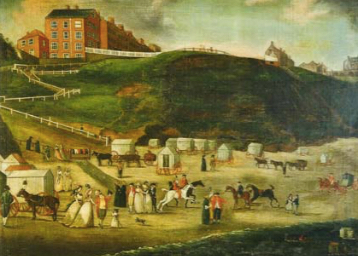Martin Fone's Blog, page 109
October 2, 2022
Squirrel Of The Week

Red squirrels might be so scarce in Britain because of the loss of their habitat and their inability to compete with the imported grey squirrel but their poor gastronomic choices might have something to do with it.
A red squirrel broke into the Atholl Road branch of Greggs in Pitlochry through the eaves on a Saturday night and refused to move out, forcing locals had to do without their sausage rolls for several days. The squirrel’s occupation was manna from social media heaven for Greggs who shared updates of the chase with their followers and were finally able to tweet four days later that “after giving us the run around, we managed to catch the Greggs squirrel safe and sound”.
They posted a video of it being released into the the nearby Faskally woods. The shop then had to be thoroughly deep cleaned – every cloud has a silver lining – but is now open for business again.
Perhaps the squirrel will stick to nuts next time it feels hungry.
October 1, 2022
Porridge Of The Week (2)

If you are a porridge lover, here are two dates for your diary. October 10th is World Porridge Day while two days earlier the 29th World Porridge Making Championship makes a welcome return. While the hotly contested competition to secure the Golden Spurtle was held in 2020 and 2021 Covid restrictions forced it to be held virtually. Not this year, though, and so competitors, fans and onlookers will be able to see the fun for themselves at the Village Hall in Carrbridge.
First held in 1994 the title of World Porridge making Champion and the prestigious Golden Spurtle is awarded to the competitor producing the best traditional porridge, made from pinhead oatmeal. Each competitor is to produce at least 2 pints of the porridge, served in four bowls, and oatmeal must be untreated and only water and salt can be added. Consistency, colour, taste, and hygiene are the criteria upon which the entries will be judged.

There is also an award for the best specialty porridge, made from untreated pinhead oatmeal and any other ingredients the contestant chooses to use. The blending and harmony of the porridge with the other ingredients will be the key judging criterion.
A spurtle is a traditional Scottish utensil, dating from the 15th century, used to stir the mixture. Its rod-like shape means that the porridge can be stirred without congealing or forming lumps.
Let battle commence.
September 30, 2022
Laurels Are Poison

A review of Laurels are Poison by Gladys Mitchell
Gladys Mitchell’s books are never an easy read, as she twists and contorts the conventions of the detective novel genre and there is a distinct feeling of satisfaction to be gained when getting to the end and still having a vague appreciation of what has gone on and how it all hangs together. Mitchell is never one to hide the arcana of her knowledge and an appreciation of the Greek myth of Itylus helps immeasurably in this fourteenth book in her Mrs Bradley series, originally published in 1942. The culprit even quotes extensively from Algernon Swinburne’s poem of the same name in their confession.
The book also marks a distinct change in direction for her later books, whether for the better only time will tell as I plough through them in chronological order. Among the students at the teacher training college that is Carteret Training College are the self-styled Three Musketeers, Kitty Trevelyan, Alice Boorman, and Laura Menzies, the latter becoming Mrs Bradley’s amanuensis and ersatz-Dr Watson as the series progresses. It also introduces us to Deborah Cloud who goes on to marry Jonathan, one of Mrs Bradley’s nephews, by the end of the book.
Mrs Bradley has arrived at Carteret, ostensibly to take up the position of Warden of Athelstan, one of the houses at the college, but, in reality, to discover what had happened to the previous incumbent, Miss Murchan, who disappeared without trace at the climax of the summer ball. Deborah Cloud is her sub-Warden and is let into the secret while the Three Musketeers, who are all jolly hockey sticks and a bit famous-fiveish, are recruited for their inside knowledge.
Mitchell writes with great verve and panache, clearly revelling in the opportunity to describe life in a teacher training college, which, as an educationalist, was close to her heart. She regarded it as one of her best books and it is full of humour, action and meaningful observations, written in a style that is less convoluted than some of her earlier novels but never afraid to throw an obscure word at the reader to test the range of their vocabulary.
There are what are known as rags, exercises in high spirits by the women of the college and, from time to time, the men from the nearby college, some of which are exhibitions of youthful high spirits, but others which have a more sinister nature to them. There are mysterious sounds at night, jolly japes with a couple of anatomical skeletons, a sticky tar-like substance is spread over the floor of the basement, a pyre-like construction is made from commodes, a girl has her hair chopped off and Mrs Bradley is subjected to some physical danger. She is threatened with a gun, is stalked through the school, and has a brick thrown at her. These incidents pass in and out of the narrative, like pieces of surreal absurdism.
There is a body found floating in a nearby river, but it is not Miss Murchan. Instead, it is the cook, recently dismissed by Mrs Bradley, and as her corsets are found separately, it is suggested that it was murder and not suicide and that the foul deed was carried out elsewhere. Why would the cook be murdered? Perhaps she had some information that the murderer did not want shared.
As the narrative reaches its climax the all-important back story slowly emerges and we begin to understand the relationship between the improbably named Miss Cornflake and the missing Warden, what the cook knew, and why she was murdered. It involves a tragic accident, revenge, sibling jealousies, and knowing too much.
Of course, Mrs Bradley gets her man, although they escape the arms of justice by doing away with themselves, thus sparing the College the bad publicity the Principal was keen to avoid. It was an enjoyable romp and one of Mitchell’s best that I have read.
September 29, 2022
Bax Botanics

Aimed at those who eschew alcohol out of choice, for medical reasons, or because they have been lumbered with the chore of being the designated driver, the no or low alcohol (NoLo) drinks are fast becoming the hottest sector in the drinks market. Wetherby-based Bax Botanics, the brainchild of Chris and Rose Bax, is a company that is looking to demonstrate that just because a drink is alcohol-free, it does not mean that it cannot be as tasty, complex, and versatile as its alcoholic competitors.
Chris and Rose have used their experience of thirty years or so in the food industry focussing on discovering on delicious and exciting ways to use wild ingredients and culinary herbs to good effect. Now branching out on their own, they use organic and ethically sourced wild herbs, roots, and berries in recipes developed to bring out not only the best of their chosen ingredients but also to produce a drink that is complex and one that can be drunk neat, with a mixer or as part of a cocktail. To ensure that they maximise their environmentally friendly, sustainable credentials, they use recyclable and recycled packaging, and their labelling is made from a by-product of the sugar industry.
The bottles (50cl) are made of clear glass, circular, with a rounded shoulder leading to a short neck, and a wooden cap with a synthetic stopper. The labels make use of gloriously colourful and slightly abstract photographs of the cells of their range’s principal botanicals as seen through a scientific microscope and carry the colour scheme, green for Bax Botanics Verbena and orange for Bax Botanic Sea Buckthorn, to the top so they can be easily distinguished. There is no need to refrigerate the drink, although it is recommended that it is stored in a cool place and consumed within six months of opening. For those who want to dip their toes in the Bax Botanics’ waters, they also produce a 250ml can with a pre-mixed serving for each of their range. The added bonus is that they contain just 48 calories.

Lemon verbena is a wonderfully citric herb, used to flavour fish and poultry, and medicinally to help ease digestive disorders. I was looking for a zesty, refreshing drink and I was not disappointed. Opening the bottle for the first time, I felt that I had stepped into a herb garden, surrounded by the aromas of mint, fennel, and lemon. In the glass it is clear and complex, a soothing mix of citrus, fennel, mint, and summer herbs and with a slightly liquorice-like aftertaste to finish. It is not recommended that it be drunk neat and the addition of a premium tonic – the suggested serving ratio is 3 parts tonic to 1 part of the drink – seemed to enhance the taste of the botanicals, giving them a new lease of life and adding another layer of complexity to the drink.

A favourite of Pegasus and used in many horse supplements, the vibrantly orange-coloured sea buckthorn berries, sour and tart to taste with a hint of sweetness, are packed full of vitamins and antioxidants, and, medicinally, has been used in skin care and as an anti-ageing agent. Bax Botanics’ Sea Buckthorn is almost the antithesis of their Verbena, replacing bright and crisp with bittersweet, as the tartness of the Buckthorn is complemented with the bittersweet taste of Seville oranges, supported by herbs such as Rosemary and Thyme, leaving a slightly dry and almost peppery aftertaste.
Initially, I was not sure about the Sea Buckthorn, but after a second glass, I realised that it was a subtler, more sophisticated drink than the more overtly pleasing Verbena, one whose complexities take time to appreciate. Both are welcome additions to the burgeoning Nolo market and for distilled alcohol-free infusions, their price point, at a tad under £20, is attractive enough to encourage those who want to see what all the fuss is about.
Until the next time, cheers!
September 28, 2022
Smallbone Deceased

A review of Smallbone Deceased by Michael Gilbert
Originally published in 1950 and now reissued as part of the excellent British Library Crime Classics series, Smallbone Deceased is the fourth in Michael Gilbert’s Inspector Hazelrigg and is a must-read for all fans of Golden Age detective fiction. It has many of the elements that make up a good yarn, a seemingly impossible murder, misdirections and red herrings galore, and an amateur sleuth in the form of newly arrived solicitor, Henry Bohun, all underpinned by Gilbert’s inside knowledge of life in a London solicitor’s office. Above all, it is great fun.
Having been a partner in a legal firm himself, Gilbert paints his setting convincingly, alive to the tedium of office life, with its set routines, its petty jealousies, underlying and barely disguised tensions and rivalries. His characters are wryly and sharply observed and although stereotypical, are believable. The reader gets to know them, understands how they interact and becomes aware of the politics of a firm that on the surface is outwardly respectable and prosperous but in reality is struggling.
It has been rocked by the death of the senior partner, Mr Horniman senior, who has finally succumbed to his weak heart, and the prickly Mr Birley and the more approachable Mr Birley along with the newly promoted son of Mr Horniman are left to navigate the firm through choppy waters. One of Horniman’s lasting legacies is an orderly administrative system with a place for every paper and deed and every paper and deed in its place. Into this order, Gilbert mischievously adds a twist of the macabre.
Inside one of the firm’s seventeen deed boxes is found a body. It is not just any old body but that of Marcus Smallbone, the other trustee of a trust that Horniman senior was administering. Smallbone, whom we never meet alive, was seemingly an unpleasant individual and liked little more than digging up the dirt on others, not for pecuniary gain but for the satisfaction of getting one over his victims. The suggestion is that he has found out that Horniman has perpetrated a fraud to keep his firm afloat. As Horniman senior could not have murdered Smallbone, who did it?
Inspector Hazelrigg leads the investigation from the police perspective and enlists the assistance of Bohun who conducts enquiries from the inside. Unlike many writers who use the combination of professional police and amateur sleuth to highlight the stupidity of the former and the brilliance of the latter, Gilbert shows them working well together as they set about cracking a difficult case. Through dogged persistence the duo work out that there was only a particular window of opportunity for the murderer to strangle the victim, forensic evidence suggests that the culprit was left-handed, secrete the body in the deed box and remove the papers from an office where any paper out of order was instantly spotted.
It turns into one of those stories where alibis are tested and charts are developed showing the precise movements of suspects. However, Gilbert writes with considerable verve and handles the alibi testing with a commendable light touch. The suspects are whittled down until it can only be one and to many a reader their identity may come as a surprise. The one weakness of the book is motivation. Loyalty can exercise a powerful hold on an individual but is it enough to lead someone to commit a murder, never mind buy a new rucksack?
Despite this reservation it is a wonderful book and is thoroughly recommended.
September 27, 2022
The Pit-Prop Syndicate

A review of The Pit-Prop Syndicate by Freeman Wills Crofts
At his best, Freeman Wills Crofts can be a bit of a challenge, but this early effort, originally published in 1922, is enough to try the patience of even his most fervent advocate. It falls distinctly into two uneven parts, both in terms of length, interest, and quality. The first half, entitled The Amateurs, is so dated to modern eyes that it is almost unreadable and is written in a Boys Own Paper, gung-ho British adventurer style. The second part, The Professionals, is a more conventional, and more satisfying, police procedural.
One of our amateur protagonists, Seymour Merriman, is on a motoring holiday in Bordeaux, runs out of petrol, and gets a lift to a nearby wood mill that produces pit-props. Two things happen to him that shape the rest of the story. He spots a driver of a lorry change its number in suspicious circumstances and he espies the factory manager’s daughter, Madelaine, with whom, astonishingly, he falls in love.
On his return to Blighty, Merriman interests his friend, Claud Hilliard, who happens to be a Customs man, in the goings-on in the wood outside Bordeaux. Hilliard is immediately suspicious, thinking that there may some form of liquor smuggling racket going on, the discovery of which would boost his career aspirations no end. Hilliard immediately proposes a sailing trip to France, as you do, to take a closer look at the pit-prop factory. Merriman agrees, anxious to see his beloved again and, if Hilliard’s suspicions are well-founded, to rescue her from danger.
The duo’s adventures in Bordeaux border on high farce with them staking out the joint for days on end, secreted in a cask into which they have bored two eye holes. They are convinced that something fishy is going on and that Madelaine’s father is a reluctant participant. However, they are far from certain what the pit-prop business is a front for, perhaps smuggling spirits or counterfeit notes, but they do trace the English side of the operations to Ferriby where they also carry out some inconclusive investigations. It is the murder of Madelaine’s father in a London cab that persuades Merriman to take what would have been the obvious course of action, to alert the police, and brings Inspector George Willis into the story.
Willis, too, has fun trying to crack the gang’s operations, staking out the Ferriby factory and engaging in a bit of wiretapping. Although he is more professional and structured in his approach, he finds his opponents are slippery and manages to fall into their traps with monotonous regularity. Oddly, the murder is solved in a matter of pages, the culprit having obligingly left a clear set of dabs on the connecting phone in the cab and is really a minor sideshow in what is a mystery about how a pit-prop syndicate can find it economically viable to send their goods one way without a return cargo.
Eventually Willis cracks the gang’s mildly ingenious modus operandi, all the culprits are arrested and, naturally, Merriman wins his girl.
Some of the characteristics that make Crofts’ novels so distinctive are already in evidence. There is a well-considered scheme, ingenious in its construction, there is an endless obsession with modes of transport and the minutiae of timetables and the precise speeds that would need to be travelled to get from A to B in a given time. It is not enough for Crofts to put his character on a train. The reader is told which train and even where it might stop. Willis, in a rush, frets whether the car will be capable of maintaining an average speed of 30 mph, a bit of an eye-opener for the modern reader.
However, what does for this book is that it is overly long, very dated, and utterly dull. It might have worked as a short story or even a novella, but much of what Merriman and Hilliard do really does not move the story on and could have been excised with little impact on the integrity of the story.
Sadly, there are better ways of spending an evening than with this, not least with a glass of brandy!
September 26, 2022
Captain Webb, The Dawley Man

Like Everest, it presents an irresistible challenge to the adventurous, simply because, to echo George Mallory, it’s there. At its narrowest point, between Shakespeare’s Beach at Dover and Cap Gris Nez, a headland between Calais and Boulogne, the English Channel might just be 18.2 nautical miles wide, but it forms a formidable barrier that tests the endurance, skill, and enterprise of all but a select band of long-distance swimmers.
These days the favoured starting point is Abbot’s Cliff beach on the south side of Samphire Hoe, about two kilometres from Dover, making it a slightly longer swim, the starting time usually an hour either side of high tide. Permission has to be sought from either the Channel Swimming Association or the Channel Swimming and Piloting Federation, while the French authorities’ marked reluctance to sanction swims means that crossings from France to England are almost a thing of the past.
Despite all the hurdles and challenges, to date there have been 4,133 successful Channel swims, with 1,881 swimmers completing 2,428 solo swims[1], plus another 8,215 swimmers who have taken part in relay swims and special category swims. Famously, Captain Matthew Webb was the first.
Endurance swimming had become popular in the 1870s and after reading of an unsuccessful attempt to cross the Channel, Webb, a strong swimmer, decided to try his luck. After some acclimatisation in the cold waters of the southern English coast, he made his first attempt on August 12, 1875. Webb, though, was beaten by the high winds and adverse weather conditions he experienced.
Undaunted, wearing a red silken swimming costume and his body smothered in porpoise oil, he tried again twelve days later, followed by three boats, supplying him with brandy, coffee, and beef tea. Swimming the breaststroke, he had to endure jellyfish stings, avoid patches of seaweed, and disconcertingly, eight miles short of Cap Gris Nez, a change in tide which forced him to swim for five hours along the French coast waiting for it to abate. Eventually, at 10.41 am on August 25, 1875, Webb clambered wearily on to the shore, having swum the equivalent of 39 miles, mostly against the tide, in 21 hours and forty-five minutes.
News of his achievement spread around the world. The Daily Telegraph proclaimed the Captain to be the best-known man in the world, the mayor of Dover opined that no one would repeat the feat, and so enthusiastic was the crowd that greeted him at Wellington station on his return to his native Shropshire that a section uncoupled the horses that were to convey him on to Ironbridge and pulled him along themselves. At Dawley he received “the homage of the town of his birth” and was paraded down the High Street.
Now wealthy and an international celebrity, Webb was not content to rest on his laurels, a decision that was to cost him his life. On July 24, 1883, he attempted to swim across the Niagara Rivers, just down from the Falls. Within ten minutes of entering the water, he was drowned in a whirlpool, his body only recovered four days later. In 1909 Webb’s older brother, Thomas, unveiled a memorial to him in Dawley which bore the legend “Nothing great is easy”.
Next week we will take another dip into the English Channel.

September 25, 2022
Another Dip In The Sea

Taking a dip in the sea was not just prescribed for the infirm. To maintain a healthy constitution, physicians recommended that men bathe daily for five minutes before breakfast while two minutes three times a week was enough for the “weaker sex” and children. The coast also offered an attractive alternative to the tedium of everyday life, as the poet William Cowper noted in Retirement (1782); “but now alike, gay widow, virgin, wife,/ ingenious to diversify dull life,/ and all, impatient of dry land, agree/ with one consent to rush into the sea”. Offering both a mineral spa and the sea, Scarborough became one of Britain’s first, if not the first, seaside resorts by the early 18th century.
While men were able to bathe in puris naturalibus, a practice not banned until 1860, women, to preserve their modesty, entered the sea either fully clothed or in their voluminous undergarments. The idea of mixed bathing was contentious, many resorts adopting a prurient approach by segregating the beach and, by extension, the sea into men-only and women-only areas or imposing set times when one or other of the sexes could bathe.
A bathing machine provided a means for bathers to enter the sea with their dignity intact. John Setterington’s engraving of a beach scene at Scarborough from 1735, which can be seen at the town’s public library, shows an early example, a wooden hut on four wheels with a door at each end. According to Tobias Smollett (The Expedition of Humphrey Clinker (1771)), the bather climbed some wooden steps to enter the machine and undressed while a horse guided by the attendant pulled it to a point where the sea was level with its floor. The bather then plunged headlong into the sea, and when they had finished, clambered back on board to dry off, redress and be conveyed back to the shore. Benjamin Beale refined the design in 1750 by adding a large canvas hood, known as a tilt, which extended the rear of the machine and was supposed to provide extra protection from prying eyes.

A common sight on British beaches for the next 150 years, bathing machines cost six pennies to hire, plus a gratuity for the attendant. Once the bather had returned safely to the shore, the machine was hired out again, although later users would often find that the interior was wet and sandy. They only fell out of fashion towards the end of the 19th century, a recognition, to echo a correspondent to The Graphic in the 1870s, that “it is absurd that a house, a horse and an attendant are necessary to get someone into the sea”. By 1904 Scarborough had replaced them with bathing tents and the last were used in Margate in 1927.
From 1888 until 1914 Folkestone’s beach housed Walter Fagg’s patented bathing machine, two carriages, holding up to nine people each and equipped with clothes pegs, looking glasses, hat racks, wash basins, and even lavatories. Running along tracks sunk into the sand, the carriages were lifted in and out of the sea by a cable attached to a stationary steam engine.
The prospect of men and women in the sea still mortified many, one visitor to Scarborough fulminating that “mixed bathing is the halfway house to mixed sleeping and might be a plank on the river leading to the Niagara of eternal damnation”. Resorts vainly tried to impose standards, segregating beaches, and fining those who disregarded the byelaws.
An owner of a bathing machine at Lytham, according to The Preston Guardian of July 13, 1850, took three gentlemen down to an area reserved for females and received a fine of one shilling with costs of 9s.6d. for his troubles. With the railways bringing hordes of day-trippers eager to sample all that the seaside could offer, the authorities slowly began to realise that they were fighting a losing battle and most of the petty restrictions were abolished or allowed to lapse.
Apart from safety considerations, we are now free to enjoy the sea as we please. How times have changed.
September 24, 2022
Swap Of The Week

Necessity is the mother of invention they say. With Ukraine and Russia accounting for around 80% of the world’s sunflower oil production, many European countries are feeling the pinch with supplies running out or rationed.
Having run out of oil one night, the managers of Giesinger Bräu, a brewhouse and pub in Munich, scratched their heads and came up with an innovative plan to ensure that they would always have enough to cook their punters their schnitzels with. They have launched a barter system, offering a litre of the brewery’s finest ale to any customer in return for a litre of sunflower or rapeseed oil.
With a litre of beer costing €7 and a litre of oil €4.5, it seems a great deal, with customers swapping over 400 litres at the time of writing. One enterprising customer, Moritz Baller, bought 80 litres of sunflower oil on a recent trip to Ukraine delivering humanitarian aid and swapped it for eight crates of beer to fuel his birthday party.
A case of greasing the palm, you might say.
September 23, 2022
Blue Murder

A review of Blue Murder by Harriet Rutland
“It is better to burn out than to fade away”, sang Neil Young, or at least you should leave your audience wanting more. This sums up Olive Shimwell’s brief career as a crime novelist to a tee, her third and last novel being this astonishingly delicious dark, brooding, psychological drama, originally published under her nom de plume of Harriet Rutland in 1942 and reissued by Dean Street Press.
Although it contains a high body count, three people are murdered, and there is a police investigation, conducted primarily by Driver and Lovely, the latter there to set up some disarmingly comedic interchanges, Blue Murder is unconventional in its structure and format. It is set during the Second World War when evacuees are placed in seemingly safe havens such as Never Naughton. Arnold Smith, a novelist down on his luck and keen to turn his hand to crime fiction, like any other Tom, Dick and Harriet as Rutland self-deprecatingly declares in Chapter 35, has answered an advertisement to seek paying refuge in the home of the local headmaster, Hardstaffe.
He is not the only refugee. One of the servants is an Austrian Jewess, Frieda Braun, who has moved from the frying pan of the German concentration camps to the fire of the Hardstaffe establishment. She is treated abominably, especially by Hardstaffe’s daughter, Leda, whose anti-semitism is expressed loudly and frequently. Rutland is sympathetic to Braun’s plight, taking time to explain her experiences and the horrors that she has escaped from, a move that makes Leda’s behaviour even more loathsome. To complete the trio of Hardstaffes in residence is Mrs Hardstaffe, a hypochondriac who is brow-beaten by her husband but is alive to his womanising, especially his affair with his latest floozy, schoolteacher Charity Fuller.
There is an air of anarchy to the household, contributed to by a pack of unruly and barely house-trained Sealyhams, and it is a place simmering with hatred, each of the principal characters expressing thoughts of murder before the book has barely begun. Of course, there are murders. First to go is Mrs Hardstaffe who seems to have been poisoned with a dose of morphia. She was convinced that her sleeping tablets contained morphia, although at the inquest her physician, Dr Macalistair, reveals that they were merely placebos. Braun, though, did have morphia, her last form of defence if she were captured by the Germans.
Then Mr Hardstaffe is murdered, shortly after an assignation with Charity Fuller when she rejected his advances and declared she could kill him. Were the two murders related and was it significant that they both occurred after Fuller had visited the house. Hardstaffe, modelled on Whackford Squeers, was a despicable man, and there were others who would have cheerfully murdered him, not least the father of the son he had brutally chastised, and Stanton, Hardstaffe’s estranged son, who was lurking near the house around the time of both murders.
Police investigations come to naught despite a confession which, surprisingly, is marked down as the result of hysterics, and they have disappeared from the scene by the time of the mystery’s resolution. Although the identification of the culprit comes as little surprise, it delivers a third murder and the pendulous question of whether the culprit ever paid for their crimes.
What intrigued me about the book was Rutland’s willingness to move away from the cosiness of the traditional crime novel and explore the darker side of life, domestic abuse, anti-semitism, sexual desire and illicit relationships. According to the excellent introduction, she was going through a dark period in her own personal life and it was written at the height of the war when the outcome was far from clear.
She has produced a powerful study of a household where violent emotions reigned supreme. That it led to murder comes as no surprise at all. When I had finished this wonderful book, I realised what a truly great loss to fans of crime fiction Rutland’s decision not to write anymore was. Perhaps she was tired of being another Tom, Dick or Harriet.



